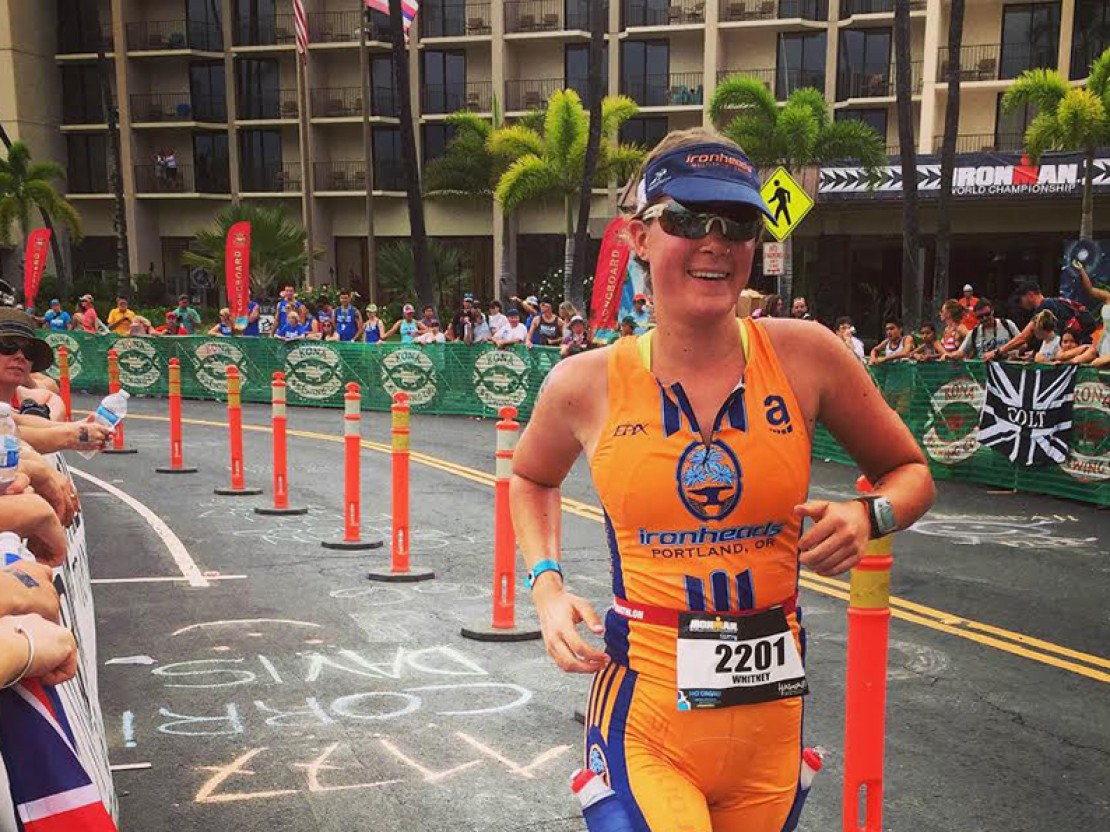The alarm clock rang. It was 3:30 a.m.
The sunrise was nowhere in sight as Whitney Dawson ’12 set off in pitch darkness to start her long day.
First, there was a check-in, and then getting her race number tattooed (temporarily) on her arms, followed by a weigh-in. Once all of these logistics were taken care of, the real fun was about to begin.
At 6:30 a.m., just as the sun rose over Kailua Bay, a cannon-shot signaled the start of the race with competitors diving into the Pacific Ocean for the first leg of one of the most iconic Ironman triathlons around: a 2.4-mile ocean swim.
“I loved the whole starting-line experience,” Dawson said about the event, which was her second Ironman competition. “The cannon and all the cameras and just the energy in the area at the start were just insane.”
Few people on the planet have an interest in going out and completing a 2.4-mile ocean swim, 112-mile bike race or 26.2-mile run all in one race. Fewer still have the will, determination, and fitness to attempt even one of these.
There is, however, an elite group of athletes who can complete this grueling trifecta within the 17-hour time limit, sometimes staged in some of the harshest racing conditions in the world. Each of these individuals earns the right to call himself an Ironman, although, in Dawson’s case, “Iron Athena” is more like it.
A former distance swimmer for Claremont-Mudd-Scripps who graduated with a degree in Environment, Economics, and Politics (EEP), Dawson competed at the Ironman World Championships in Kona, Hawaii, in the fall and finished an impressive ninth in the women’s amateur 18-24 division.
Confronted with the notoriously windy, hot, and dry conditions that give Kona its reputation as the toughest triathlon, Dawson’s time was 11 hours, 42 minutes, and 11 seconds.
Triathlons are in her blood. Dawson’s mother Bridget is also a triathlete, winning her age group at the world championships in 2012 in New Zealand.
“I actually became a swimmer at a very young age because my parents believed that swimming is the hardest part of a triathlon,” she explained, “so that’s what stuck with me, and I swam all the way until the end of college.”
Dawson began competing in triathlons when she was nine. How many has she competed in since her pre-teen start? “Too many to count,” she says, laughing.
Off to an impressive start
Despite being a triathlon veteran, it wasn’t until the summer of 2014 that she competed in her first full Ironman event: Ironman Canada. With the stunning mountain scenery of Whistler, British Columbia, Whistler Mountain serving as a backdrop, Dawson overcame a difficult, extremely hilly course and raced her way to a first-place finish in her age group.
Not bad for her first-ever Ironman.
“Hills on hills on hills were the name of the game,” Dawson said about the event. “It was a tough day, but very rewarding.”
Winning her age group in Whistler qualified Dawson for the World Championships in Kona, which were held about two months later. That didn’t give her much time for training considering the amount of time needed for recovery.
“It takes about a month to recover from an Ironman which sounds unbelievable until you do one,” she said, “and then it makes perfect sense.”
After her recovery from Whistler, Dawson spent the remaining month training for the World Championships with the help of a coach who has raced Kona ten times. Training consisted of swimming and running four times a week with a long run mixed in with two short, mid-week bike rides and a long ride on Saturdays.
Race day: A tough marathon leg
After training back home in Oregon, Dawson and her team flew to Hawaii eight days before the World Championships to get acclimated to the course and climate. On race day, Dawson said she completed the swim comfortably in slightly over an hour—that ranked her as second in her age group with the 112-mile bike ride and marathon still to follow.
“The bike portion was fun even though it was insanely windy with head winds and cross winds,” she said. “That was a little nerve-wracking but it’s all part of the experience.”
Faced with the hot and windy conditions, Dawson completed the second leg of the race in six hours and five minutes, which ranked her at sixth in her division. Dawson said the third and final portion of the race was the most difficult.
“The toughest part for me definitely was the run which I was expecting because I had dealt with several injuries this year,” she said. The injuries “didn’t allow me to train in the way that I wanted to leading up to the race.”
By the time she started the marathon, she had already been racing for over seven hours. The last four-and-a-half hours of running were the most difficult.
But, looking back at her undergraduate experience, she said it was her years of swim training with CMS swim coach Charlie Griffiths that helped her through the run.
“I can’t tell you how many times in swim training over the years that I have wanted to stop,” she said, “but I learned how to push through.”
So what’s next? Aside from continuing her work for Portland-based startup Athletepath, a social networking platform for athletes, Dawson says the answer is simple: Another Ironman of course.
“Mostly I feel like I have something to prove,” she said. “With such minimal run training and now two [Ironman] races under my belt, I know I’m nowhere near my full potential. I couldn’t have asked for more out of my first year of Ironman racing, but I am anxious and excited for the next [race] already.”
Chris Watts is Director of Athletic Communications at CMC.
Read Dawson’s account of her Ironman experience at Medium.com.
